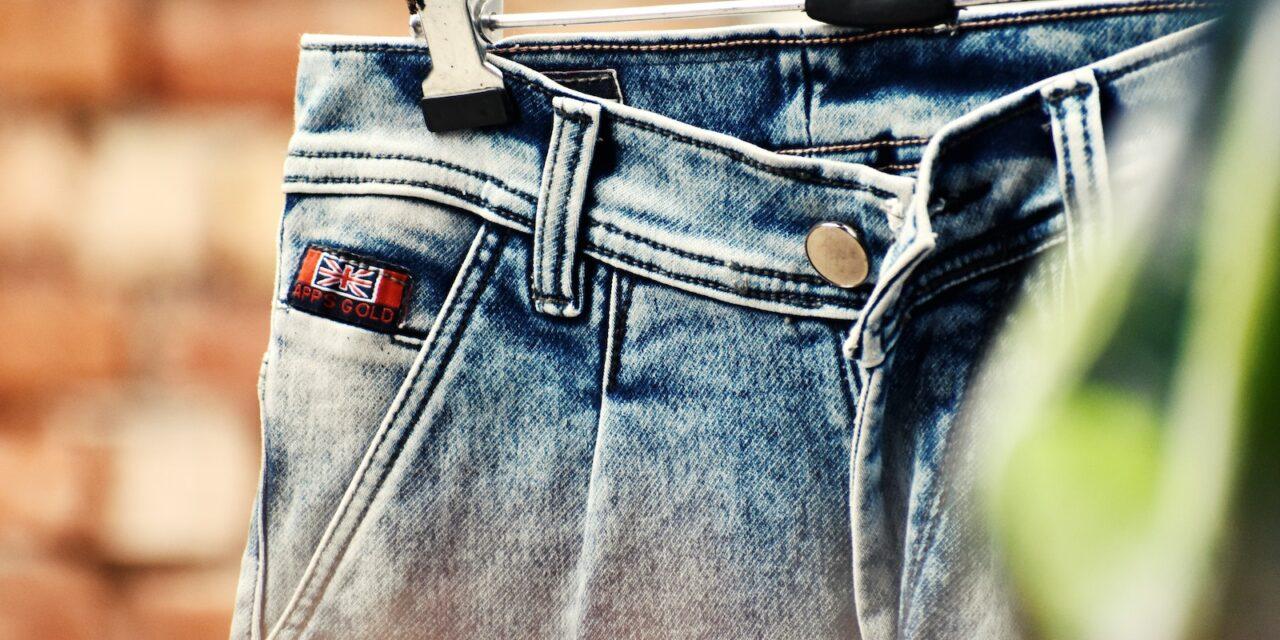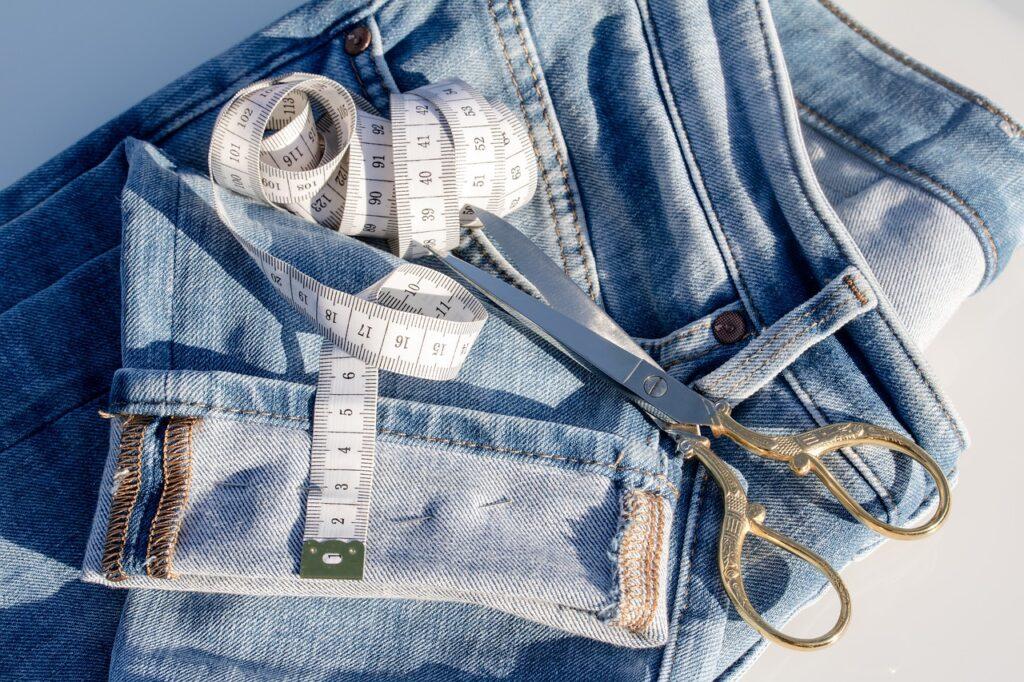Jeans are a staple item in most people’s wardrobes, and for a good reason. They are versatile, comfortable, and stylish. In this article; Should you size up or down in jeans, you will discover why the pros and cons of sizing up or down in jeans.
However, finding the right size in jeans can be a challenge for many people. Wearing ill-fitting jeans can result in discomfort, unflattering appearance, and even long-term health issues.
Therefore it’s crucial to pay attention to finding the perfect fit. When it comes to choosing your ideal size of jeans, there is no one-size-fits-all approach.
Every person has different body shapes and proportions that require specific measurements to ensure adequate coverage and comfort level. In addition to physical considerations, other aspects such as fabric type and stretchiness can also affect how your jeans fit you.
The Debate Between Sizing Up or Down
The debate over whether to size up or down has been ongoing amongst jean lovers for decades now. Some people swear by sizing up because they believe it provides more flexibility or room for weight fluctuations over time. Others assert that sizing down is better because it results in a flattering silhouette.
However, it’s not that simple. There are pros and cons involved with each option that must be considered before deciding on which way is best for you.
Therefore this article will explore the different factors that influence your choice when selecting jean size as well as examine the contrasting benefits and drawbacks of either sizing up or down. As such, let’s delve into each factor you should consider when determining your ideal jean size below.
Factors to Consider When Choosing Jean Size
Jeans are a staple in every wardrobe, but finding the perfect fit can be a frustrating task. Whether it’s tight waistbands or saggy bottoms, ill-fitting jeans can quickly put a damper on your fashion sense and confidence. To avoid this, there are several factors to consider when choosing the right jean size.
1. Body Shape and Proportions
When it comes to selecting the ideal jean size, body shape and proportions play a critical role. People with apple-shaped bodies tend to carry weight around their midsection, while those with pear-shaped bodies have wider hips and thighs.
It’s essential to choose jeans that flatter your body shape by accentuating your best features. Furthermore, determining your waist-to-hip ratio can help you find jeans that fit perfectly.
2. Fabric Type and Stretchiness
Fabric type and stretchiness are also crucial factors when selecting jean sizes. Jeans come in various fabrics such as denim, cotton, polyester blends, among others.
Each fabric type has unique properties that affect its stretchiness level. It’s important to keep in mind that stretchy materials like elastane tend to be more comfortable than non-stretchy materials like raw denim but may not provide as much support for people who prefer tighter fitting jeans.
3. Style and Cut of Jeans
The style and cut of jeans are also essential considerations when selecting the ideal jean size. Skinny fits hug every curve of your body while straight leg styles offer more room in the thigh area but less tapering towards the ankle than skinny styles do which makes them look baggier overall. Flared styles provide balance between slimness at the top portion of pants (thighs area) with slightly flared bottom leg openings adding some playfulness into outfits.
Another type is wide-leg or palazzo pants are characterized by wide, loose-fitting legs, which can create a stylish and fashion-forward look when paired with the right top. High-waisted jeans are also popular among many people due to their figure-flattering design that emphasizes curves in all the right places.
Pros and Cons of Sizing Up in Jeans
When it comes to choosing the right size in jeans, many people argue that sizing up is the way to go. Let’s explore some of the benefits and drawbacks of going up a size in your denim.
Benefits: Comfort, Flexibility, Room for Weight Fluctuations
One of the main benefits of sizing up in jeans is comfort. When you choose a larger size, the fabric sits more loosely on your body, allowing you to move around with ease.
This can especially come in handy if you have an active lifestyle or if you’re going to be wearing your jeans for an extended period. Another benefit is flexibility.
With a looser fit, sizing up allows for more room and less restriction when bending down or sitting. This also makes it easier to layer clothing underneath your jeans during colder months.
Sizing up can also give you peace of mind when it comes to possible weight fluctuations. If you tend to gain weight easily or are currently pregnant, choosing a larger size can save you from having to constantly buy new pairs of jeans every time your body changes.
Drawbacks: Baggy Appearance, Sagging, Unflattering Fit
However, there are also some drawbacks to consider when sizing up in jeans. One major issue is the baggy appearance that can come with a looser fit.
This may not be ideal if you’re looking for a flattering silhouette or if your personal style leans towards fitted clothing. Additionally, wearing jeans that are too big can lead to sagging throughout the day as they stretch out from wear.
This not only looks unappealing but may require constant readjustment throughout the day. Choosing a bigger size doesn’t always guarantee an unflattering fit on all body types and shapes.
You may find that this method doesn’t work for you if you’re already dealing with certain fit issues, such as gapping at the waist or too much fabric around the hips. Sizing up in jeans can be a great option for those seeking comfort and flexibility.
However, it’s important to weigh the potential drawbacks before making a final decision. If you do choose to go up a size, consider purchasing a smaller size in the same style for comparison to ensure that it’s truly the best fit for your body and personal preferences.
Pros and Cons of Sizing Down in Jeans
Benefits: Streamlined Look, Flattering Fit, Less Sagging
Sizing down in jeans can have a number of benefits. The most obvious benefit is a more streamlined look.
When jeans fit snugly to the body, they create a sleek silhouette that can be very flattering. This is particularly true for people who are looking to create a more polished or professional appearance with their clothing.
In addition to the streamlined look, sizing down in jeans can also create a more flattering fit. Because the fabric is pulled taut against the body, it tends to smooth out any lumps or bumps that might otherwise be visible.
This makes the wearer appear slimmer and more toned. Another advantage of sizing down in jeans is that it can help prevent sagging.
When jeans are too loose, they tend to bag and sag around the knees and rear end, which can be unflattering and uncomfortable. By contrast, tighter-fitting jeans hold their shape better over time.
Drawbacks: Tightness, Discomfort, Limited Mobility
While there are certainly benefits to sizing down in jeans, there are also some drawbacks that should be considered before making this choice. The most obvious drawback is tightness. Jeans that are too small can be extremely constricting and uncomfortable to wear for long periods of time.
This is particularly true for people who have larger thighs or hips since these areas tend to bear the brunt of tight-fitting pants. Another potential issue with sizing down in jeans is limited mobility.
Tight pants can restrict movement and make it difficult for wearers to sit or bend comfortably without feeling like they’re going to burst out of their pants at any moment. It’s important to note that not all body types will benefit from sizing down in jeans.
People with larger frames may find that tight-fitting jeans highlight areas of their body they would rather not draw attention to, and can actually be less flattering than looser-fitting options. Overall, while sizing down in jeans can definitely have some advantages, it’s important to carefully consider the potential drawbacks and weigh them against personal preferences and style goals before making a decision.
How to Determine Your Ideal Jean Size
Finding the perfect pair of jeans can be a daunting task, especially when it comes to deciding on the right size. While there are general guidelines to follow, such as choosing a size based on your body measurements or trying on different sizes and styles, there is no one-size-fits-all answer. However, by considering several factors and following a few tips, you can determine your ideal jean size with confidence.
Measuring Yourself Accurately
The first step in determining your ideal jean size is to measure yourself accurately. Taking accurate measurements will give you the most reliable information for sizing charts and help you choose jeans that fit well.
Start by measuring your waistline, hip circumference, inseam length (from crotch to ankle), and thigh circumference. You can use a flexible tape measure or a piece of string that you later measure with a ruler.
When taking measurements for jeans, it’s important to wear form-fitting clothes that don’t affect the results. Stand up straight while measuring and make sure the tape measure is snug but not too tight around your body.
Trying on Different Sizes and Styles
Once you have an idea of your body measurements, it’s time to try on different sizes and styles of jeans. Many people prefer buying jeans in person rather than online since trying them on in-store ensures a better fit.
Don’t be afraid to try several sizes or styles until you find the perfect pair. If you’re unsure which style or cut of jeans will suit your body shape best, consult with a professional stylist or salesperson who can provide guidance based on their experience working with various body types.
Consulting with a Professional Stylist or Salesperson
If you’re still struggling to find the perfect pair of jeans, consider consulting with a professional stylist or salesperson. They can help you determine your ideal jean size based on your body measurements and style preferences. Additionally, they can recommend specific denim brands and styles that suit your body type best.
A stylist or salesperson can also provide tips on how to care for your jeans properly, such as washing and drying techniques that preserve their shape and color. With their expertise, you’ll be able to make an informed decision about which jeans are right for you.
Conclusion
Throughout this article, we have discussed the importance of finding the right size when it comes to jeans. We have explored the factors that need to be taken into consideration when choosing a jean size, such as body shape and proportion, fabric type and stretchiness, and style and cut.
We have also outlined the pros and cons of sizing up or down in jeans, along with how to determine your ideal size. It is important to remember that finding the perfect jean size ultimately comes down to personal preference.
Some individuals may prefer a more relaxed fit while others may prioritize a streamlined look. As long as you feel comfortable in your jeans and maintain confidence while wearing them, you are on the right track.
Summary of Should You Size Up or Down in Jeans
When it comes to choosing a jean size, several factors need to be considered. Body shape and proportion play an important role in determining whether or not you should size up or down.
The type of fabric used in the jeans can also affect how they fit. Stretchier materials may allow for more flexibility while stiffer fabrics may provide more structure.
Both sizing up and down come with their own set of benefits and drawbacks. Sizing up can provide comfort, flexibility, and room for weight fluctuations but can also result in a baggy appearance or sagging.
Sizing down can result in a streamlined look that flatters your body shape but can also be too tight or restrict movement. Determining your ideal jean size involves measuring yourself accurately, trying on different sizes and styles of jeans, as well as consulting with a professional stylist or salesperson if needed.
Recommendations
Based on the information presented in this article, we recommend trying on both sizes before making your final decision. It is best to choose what feels most comfortable for you while also taking into consideration the style and cut of the jeans.
If you are unsure, it may be helpful to consult with a professional stylist or salesperson who can offer guidance and advice. Remember, there is no one-size-fits-all solution when it comes to choosing the perfect jean size.
Your body shape and proportions, as well as your personal preferences, should guide your decision. Ultimately, finding the right size will help you feel confident and comfortable in your jeans, no matter what style or cut you choose.











